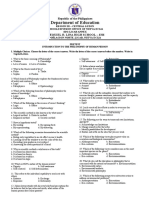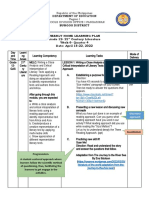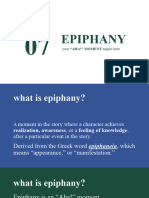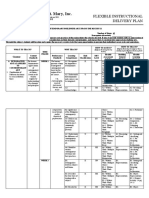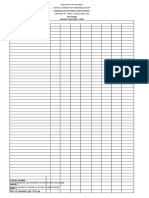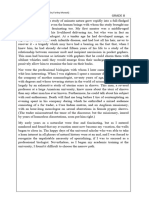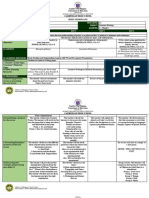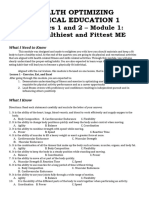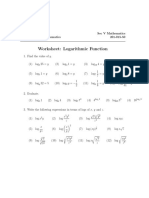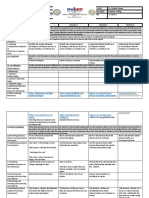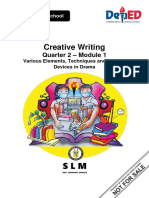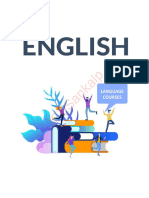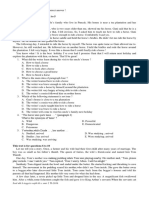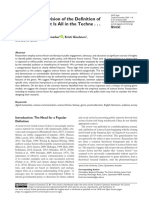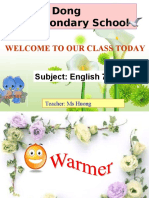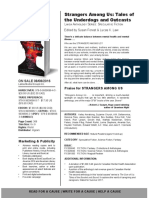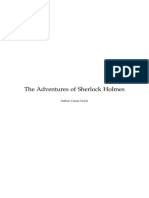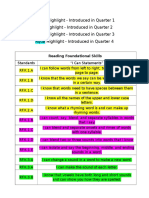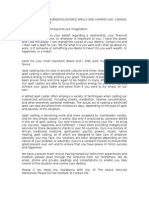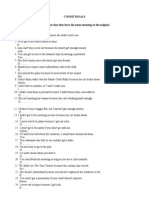Creative Writing-MET3-ATG Q1
Uploaded by
lester bessittCreative Writing-MET3-ATG Q1
Uploaded by
lester bessittArchdiocesan Notre Dame Schools of Cotabato (ANDSC)
NOTRE DAME OF PARANG, INC.
Parang, Maguindanao del Norte
A.Y. 2024 -2025
ADAPTIVE TEACHING GUIDE
Subject: Creative Writing
Quarter: 1
Grade: 11
Date: August 05 – 16, 2024
Designer: Ms. Almirah Esmael
Most Essential Topic No.1 Lesson No.1 – INTRODUCTION TO CREATIVE WRITING
Prerequisite Content-knowledge:
As a prerequisite of this lesson, the learners should have a foundation knowledge in fiction, which
includes…
Elements and techniques of a fiction.
Prerequisite Skill:
As a prerequisite skill of this lesson, the learners should have acquired skills in their previous lesson of
the first quarter, specifically in creative fiction for them to be able to easily cope up with this topic.
The learners should have the skills in…
identifying the various elements, techniques, and literary devices in various modes of fiction.
writing journal entries and other short compositions exploring key elements of fiction
Prerequisites Assessment:
1. Which of the following elements is considered a central element of fiction that involves the
sequence of events in a story?
A. Setting
B. Plot
C. Theme
D. Conflict
Key: b. Plot
2. What term is used to describe the time and place in which the events of a story occur?
A. Theme
B. Character
C. Setting
D. Dialogue
Key: c. Setting
3. Which element refers to the underlying message or main idea of a work of fiction?
A. Character
B. Plot
C. Theme
D. Conflict
Key: c. Theme
4. What is the term for the struggle between opposing forces in a story, which can be internal or
external?
A. Setting
B. Conflict
C. Irony
D. Foreshadowing
Key: b. Conflict
5. Which literary device gives hints or clues about what is to come later in the story?
A. Symbolism
B. Foreshadowing
C. Irony
D. Flashback
Key: b. Foreshadowing
6. When a character speaks their thoughts aloud while alone on stage or screen, what is this
dramatic technique called?
A. Monologue
B. Dialogue
C. Soliloquy
D. Flashback
Key: c. Soliloquy
7. What technique is used when an author includes a reference to another work of literature,
event, or person?
A. Allusion
B. Symbolism
C. Metaphor
D. Allegory
Key: a. Allusion
8. Which of the following refers to a character who opposes the protagonist in a story?
A. Narrator
B. Antagonist
C. Foil
D. Hero
Key: b. Antagonist
9. In fiction, what literary device involves using an object, person, or situation to represent
something beyond its literal meaning?
A. Foreshadowing
B. Symbolism
C. Metaphor
D. Irony
Key: b. Symbolism
10. What type of irony occurs when the audience knows something that the characters do not?
A. Verbal irony
B. Situational irony
C. Dramatic irony
D. Cosmic irony
The student will take an assessment as a prerequisite for this lesson to see how much they already
know about the lesson on element of fiction. There will be ten multiple-choice questions throughout
the assessment.
Pre-lesson Remediation Activity:
1. For Students with an Insufficient Level of Prerequisite Content-knowledge and/or Skill(s):
The learners will form a group to identify the elements of drama in a movie clip. They will be
discussing it as a group. (with figure).
2. For Students with a Fairly Sufficient Level of Prerequisite Content-knowledge and/or Skill(s):
The learners will identify the statement that describes a specific element in drama. There will
be 6 statements to identify.
Introduction:
In this lesson, we will explore the "Elements and Techniques in Drama," a fundamental topic designed
to equip learners with essential knowledge about the building blocks of theatrical performance. This
course is expected to be completed within the first two academic week, with opportunities to contact
the instructor (Almirah Esmael) during office hours or via email ([email protected]) for any
concerns or queries.
Throughout this lesson, students are expected to gain a comprehensive understanding of drama and its
core elements and techniques. This includes identifying the various elements, techniques, and literary
devices in drama, explaining intertextuality as a dramatic technique, conceptualizing characters,
settings, and plots for a one-act play, exploring different staging modalities to bring a script to life, and
writing at least one scene for a one-act play that applies these dramatic elements and techniques.
The knowledge acquired in this lesson is highly applicable across a spectrum of fields, particularly in
literature, communication, and the performing arts. It forms the foundation for understanding complex
narratives, character development, and stagecraft. In personal contexts, this knowledge empowers
individuals to appreciate the depth and creativity involved in theatrical performances, fostering a
deeper engagement with drama and its impact on culture and society.
Overview of the Lesson:
In this lesson on "Elements and Techniques in Drama," students will develop a comprehensive
understanding of key concepts that underpin dramatic works. They will explore essential elements
such as character, plot, setting, theme, dialogue, and conflict, learning how each contributes to
storytelling. Techniques like intertextuality, monologue, soliloquy, staging, blocking, and
improvisation will enhance their ability to create dynamic scenes, while literary devices such as
foreshadowing, irony, and symbolism will deepen narrative complexity. Students will also
conceptualize characters, settings, and plots for a one-act play, applying these elements and techniques
to write engaging scenes. Through this, they will gain skills in creating, analyzing, and appreciating
drama, preparing them for both creative expression and critical engagement with theatrical
performances.
Student’s Experiential Learning:
Chunk 1: Plot Development: Story Mapping
Formative question: How does the structure of the plot contribute to the overall message of the story?
Choose a scene from a story (No Other Woman) and create a detailed drawing or model of the setting.
They should label specific elements (time, place, environment) and explain how the setting affects the
mood or action of the story. Create a story map that outlines the plot structure (exposition, rising
action, climax, falling action, resolution) of a short story they have read. Each part of the map should
include a summary and illustrations to represent the events.
1. What is the main conflict in the story?
2. How do the characters’ actions influence the progression of the plot?
3. How does the climax resolve the central conflict?
4. How does the time and place of the story influence the characters’ actions and decisions?
5. What specific details in the setting create the mood of the story?
6. How would the story change if it were set in a different location or time?
Chunk 2: Drama Elements and Techniques Workshop
Formative Questions: How do the various elements and techniques in drama work together to create
meaning and impact in a scene?
In this activity, you will work in small groups to analyze a short scene from a well-known play
(Romeo and Juliet). Each group will be assigned a scene, which you will carefully examine to identify
key elements of drama: plot, character, setting, theme, and conflict, as well as literary techniques such
as foreshadowing, irony, symbolism, and soliloquy. Discuss how these elements and devices are used
in the scene to convey meaning and drive the story forward. Then, collaboratively plan and perform
the scene, paying attention to tone, gestures, staging, and the use of props to bring the elements to life.
After each performance, the class will engage in a discussion to reflect on the identified elements and
techniques and how they were represented.
1. What elements, techniques, or devices stood out in the scene?
2. How did the actors use tone, gestures, and staging to convey the characters and plot?
3. How did the conflict in the scene develop, and what was its resolution?
4. What literary devices were used to enhance the meaning of the scene?
Chunk 3: Intertextuality Exploration in Drama
Formative Questions: How does intertextuality as a dramatic technique create layers of meaning by
connecting different texts, and how can it enhance the audience’s understanding of the themes and
characters in a play?
You will work in small groups to explore the concept of intertextuality—how one text references or is
influenced by another—by analyzing and connecting a well-known play with another text, such as
Hamlet and The Lion King, and Antigone and a modern-day social justice movement. Each group will
identify plot parallels, character similarities, thematic connections, and contextual influences between
the two. Once you've completed your analysis, your group will create a short skit that combines
elements from both texts, showcasing how they interact and influence each other. Your skit should
clearly highlight the intertextual references, demonstrating how the two texts inform and reshape one
another. After performing your skit for the class, we will engage in a discussion about how
intertextuality enriches our understanding of both texts and adds layers of meaning to the drama.
1. How are the stories similar or different in structure?
2. Are the characters in one text inspired by or reflective of characters in another?
3. Do both texts deal with similar themes (e.g., love, revenge, justice)?
4. How does the historical or social context of one text affect its adaptation in another?
5. What references or parallels between the two texts did the group highlight?
6. How does recognizing these connections deepen the meaning of both texts?
7. How does intertextuality enhance the audience’s understanding or experience of the drama?
Chunk 4: One-Act Play Concept Workshop
Formative Questions: How do the characters, setting, and plot you’ve developed contribute to the
overall theme and meaning of your one-act play, and how can these elements be further refined for a
more engaging story?
You will work in small groups to conceptualize the key elements of a one-act play by developing
characters, settings, and a plot. Begin by brainstorming at least two well-defined characters,
considering their personalities, motivations, and relationships with each other. Next, choose a setting
that influences the story, thinking about how the time and place affect the characters' actions. Then,
outline a basic plot that includes an introduction, a central conflict, and a resolution. Once your group
has developed these elements, write a detailed scene outline or draft that brings your ideas together.
Afterward, you will present your character, setting, and plot concepts to the class for feedback, which
you can use to revise and improve your work.
1. What are the primary motivations of each character in your play? How do these motivations
drive the conflict?
2. How do the characters’ personalities influence their relationships with one another?
3. In what ways do the characters grow or change over the course of the plot?
4. How does the chosen setting (time and place) enhance the mood and atmosphere of your play?
5. In what ways does the setting influence the characters' actions and decisions?
6. Are there any symbolic elements in your setting that contribute to the theme of the play?
7. What is the central conflict in your one-act play, and how is it introduced?
8. How do the events in your plot lead to the climax and eventual resolution?
Chunk 5: Staging Modalities Exploration for Script Performance
Formative Questions: How do different staging modalities such as blocking, lighting, sound, and set
design influence the audience’s experience of a scene and help bring a script to life?
You will work in small groups to bring a short scene from a script to life by exploring different staging
modalities: blocking, lighting, sound, and set design. Begin by reading and analyzing the scene,
discussing how each staging element can enhance its mood, themes, and character dynamics. Plan the
blocking (actors’ movements and positions), choose appropriate lighting (bright, dim, or colored) to
set the tone, incorporate sound effects or music to add atmosphere, and design a simple set using
available props to create the setting. Once your group has finalized these elements, perform the scene
for the class, explaining how your staging choices contribute to the scene's impact. After your
performance, be prepared to give and receive feedback about how the staging modalities influenced
the audience's experience.
1. How did the staging modalities (blocking, lighting, sound, and set design) enhance the scene’s
impact?
2. How did each group’s choices affect the audience’s perception of the characters and themes?
3. What staging choices worked particularly well, and why?
SYNTHESIS
Read each question carefully and provide a concise response. Limit your answers to 2-3 sentences per
question. Ensure that your responses reflect your understanding of the concepts discussed in class
activities:
1. Define the three main elements of drama and provide an example of how each element can
influence a scene.
2. Explain intertextuality as a dramatic technique. Provide an example of how it can be used to
enhance the audience's understanding of a character or theme.
3. Describe the importance of character development in a one-act play. What techniques can a
playwright use to create complex characters?
4. What are the key features of effective dialogue in drama? Discuss how dialogue can reveal
character traits and advance the plot.
5. Identify at least two staging modalities and explain how they can impact the overall
performance of a scene.
6. Discuss how integrating multiple dramatic techniques can create a more compelling
performance. Provide an example from your previous activities.
RUA of a Student’s Learning:
Write a scene for a one-act play that showcases your understanding of character development and
effective dialogue. Your scene should include at least two characters interacting in a specific setting,
advancing a plot through meaningful dialogue and action. The scene must illustrate the characters’
motivations, conflicts, and relationships while engaging the audience through well-crafted dialogue.
Guidelines:
1. Create at least two distinct characters. Provide a brief character description that includes their
background, personality traits, and motivations.
2. Show how these characters interact with each other in your scene. Their dialogue and actions
should reflect their personalities and drive the conflict.
3. Write a scene that is 3-5 minutes long when performed, which typically equates to about 2-3
pages of script.
4. Ensure that the dialogue is natural and engaging. Use subtext, humor, or tension to convey the
emotions and relationships between the characters.
5. Make sure the dialogue contributes to the development of the plot and the characters’
conflicts.
6. Format your scene according to standard playwriting conventions, including character names,
dialogue, and stage directions where necessary.
7. Submit a typed copy of your scene along with a brief reflection (about one paragraph)
explaining how you applied character development and dialogue techniques in your writing.
3 2 1 0
The scene The scene shows good The scene meets basic The scene does not
demonstrates character development requirements but lacks meet expectations for
exceptional character and dialogue writing, depth in character character development
development and with minor areas for development and or dialogue writing
dialogue writing, improvement. dialogue; significant and requires
showcasing a strong improvement is substantial revision.
grasp of dramatic needed.
techniques.
Post-lesson Remediation Activity:
The student’s work will be assessed. If the students don’t meet the required level, the teacher will
allow the students to redo some of their work under the teacher’s supervision. A new activity will be
given again to be submitted after two days. The students can only move forward to the next lesson
if all the requirements are fulfilled.
You might also like
- Lesson Plan in Practical Research II (Grade 12) July 29-30, 2019No ratings yetLesson Plan in Practical Research II (Grade 12) July 29-30, 20197 pages
- COT 1-21st Century Literature Q4-WEEK 11-12No ratings yetCOT 1-21st Century Literature Q4-WEEK 11-124 pages
- Daily Lesson Log: HUMSS - CW/MP11/1 2-Iab-1 HUMSS - CW/MP11/12-Iab-1 HUMSS - CW/MP11/12-Iab - 1 HUMSS - CW/MP11/12 - Iab-1No ratings yetDaily Lesson Log: HUMSS - CW/MP11/1 2-Iab-1 HUMSS - CW/MP11/12-Iab-1 HUMSS - CW/MP11/12-Iab - 1 HUMSS - CW/MP11/12 - Iab-15 pages
- Culminating Performance Standard Performance Task Enabling Performance Standard Performance CheckNo ratings yetCulminating Performance Standard Performance Task Enabling Performance Standard Performance Check1 page
- Creative Writing: U-Site Brgy. Kaligayahan, Novaliches, Quezon City Senior High Schoo L (Grade 11)No ratings yetCreative Writing: U-Site Brgy. Kaligayahan, Novaliches, Quezon City Senior High Schoo L (Grade 11)32 pages
- 21st Century Literature From The Philippines and The World - Lesson 12100% (2)21st Century Literature From The Philippines and The World - Lesson 123 pages
- Tos - Midterm Contemporary Philippine Art From The RegionNo ratings yetTos - Midterm Contemporary Philippine Art From The Region1 page
- SUMMATIVE TEST 2 21ST CENTURY LITERATURE 4th QuarterNo ratings yetSUMMATIVE TEST 2 21ST CENTURY LITERATURE 4th Quarter1 page
- U2 - L2 Elements of Specific Literary Forms (CW)No ratings yetU2 - L2 Elements of Specific Literary Forms (CW)28 pages
- PRECALCULUS 2019 - 2020: Assignments Seatworks Quizzes Long TestNo ratings yetPRECALCULUS 2019 - 2020: Assignments Seatworks Quizzes Long Test1 page
- Mid Term Exam in Physical Education and Health0% (1)Mid Term Exam in Physical Education and Health3 pages
- HANDOUT HOPE 1 MOD 1 The Healthiest and Fittest MENo ratings yetHANDOUT HOPE 1 MOD 1 The Healthiest and Fittest ME16 pages
- Physical Education and Health (H.O.P.E 3) : Learning ModuleNo ratings yetPhysical Education and Health (H.O.P.E 3) : Learning Module14 pages
- Saint Paul's School of Ormoc Foundation, Inc.: Senior High School DepartmentNo ratings yetSaint Paul's School of Ormoc Foundation, Inc.: Senior High School Department2 pages
- Grade Level: SHS 21st Century LiteratureNo ratings yetGrade Level: SHS 21st Century Literature7 pages
- 21st Century Literature From The Philippines and The World (Week 4)No ratings yet21st Century Literature From The Philippines and The World (Week 4)30 pages
- I.Objectives: Drama-Techniques Types-Of-Dramatic-Devices/ Literary-Techniques-IntertextualityNo ratings yetI.Objectives: Drama-Techniques Types-Of-Dramatic-Devices/ Literary-Techniques-Intertextuality4 pages
- Quarter 1 Module 9 Solving Multi-Steps Original Problem1100% (1)Quarter 1 Module 9 Solving Multi-Steps Original Problem133 pages
- A Creative Writing 12 q2m1 Teacher Copy Final LayoutNo ratings yetA Creative Writing 12 q2m1 Teacher Copy Final Layout32 pages
- Soal B.ingg Wajib X Genap 2016 - HJ NenengNo ratings yetSoal B.ingg Wajib X Genap 2016 - HJ Neneng5 pages
- How Is Cinematography Used To Create Atmosphere in The Shower Scene of Psycho'?No ratings yetHow Is Cinematography Used To Create Atmosphere in The Shower Scene of Psycho'?5 pages
- Sentimental Figures of Empire in Eighteenth Century Britain and France Lynn Festa instant download100% (1)Sentimental Figures of Empire in Eighteenth Century Britain and France Lynn Festa instant download59 pages
- Menadue Et Al 2020 An Empirical Revision of The Definition of Science Fiction It Is All in The TechneNo ratings yetMenadue Et Al 2020 An Empirical Revision of The Definition of Science Fiction It Is All in The Techne18 pages
- Arthur Was The First Born Son of King Uther Pendragon and Heir To The ThroneNo ratings yetArthur Was The First Born Son of King Uther Pendragon and Heir To The Throne4 pages
- Songs of Innocence by William Blake (1757 - 1827) The LambNo ratings yetSongs of Innocence by William Blake (1757 - 1827) The Lamb2 pages
- The Adventures of Sherlock Holmes: Arthur Conan DoyleNo ratings yetThe Adventures of Sherlock Holmes: Arthur Conan Doyle162 pages
- Dr. PayBack, GUARANTEED TO GET BACK YOUR EX LOVER IN 72 HOURS0% (1)Dr. PayBack, GUARANTEED TO GET BACK YOUR EX LOVER IN 72 HOURS13 pages
- Second Quarter Test in DEVELOPMENTAL READING 7 Name: - Year & Section: - Score: - Test I: Matching Type Column A Column BNo ratings yetSecond Quarter Test in DEVELOPMENTAL READING 7 Name: - Year & Section: - Score: - Test I: Matching Type Column A Column B6 pages
- A Hegelian Analysis of Shelley's Frankenstein and Shakespeare's The Tempest100% (1)A Hegelian Analysis of Shelley's Frankenstein and Shakespeare's The Tempest10 pages
- Conditionals Re-Write The Sentences So That They Have The Same Meaning As The OriginalNo ratings yetConditionals Re-Write The Sentences So That They Have The Same Meaning As The Original2 pages
- Revolts of Being: Contemplating The Abject100% (1)Revolts of Being: Contemplating The Abject147 pages











